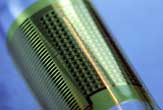New High-Tech, Flexible Pacemaker Tested on Pigs

Tiny, flexible sheets of electronic circuits that drape around the body’s organs like wrapping paper could revolutionize medical devices from pacemakers to brain implants.
The new device is a small piece of plastic, about the size of your fingertip, covered with layers of electronic circuitry made out of tiny ribbons of flexible silicon. Within the circuitry are little measuring points, 288 in total, that press up against an organ to collect and process that organ’s electrical activity.
So far, the researchers have tried out their prototype device on the beating heart of a pig.
The result: a detailed map of the heart’s electrical activity.
Current biotech
Today’s technology for spying on the body’s organs is somewhat rudimentary, and has yet to catch up with the sleek, fast and complex computer circuitry found in the iPhone or iPad, for example, scientists say.
For a typical implant, several electrodes – strips of metal that gather electrical information – are placed near an organ such as the heart or brain. Each strip is then connected with a wire to what could be considered the processing center, where electronics convert the electrical activity in the organ into electrical signals that can be tracked and measured.
Get the world’s most fascinating discoveries delivered straight to your inbox.
One of the issues with this setup: To get a good look at the heart, you need a lot of electrodes, which means a lot of wires.
“You can imagine the bundle of wires sort of growing and becoming this mess of wiring that’s difficult to connect and route, just like a mess of spaghetti [created by wiring] behind your computer,” said Jonathan Viventi of the University of Pennsylvania, one of the lead researchers on this project.
Creating a device with more than 100 wires “just isn’t feasible,” Viventi said.
And so current technologies are limited and tend to only produce a low-resolution picture of what these organs are actually doing.
“We know there’s a lot more information happening on these tissues,” Viventi told TechNewsDaily. “There’s this very fine detail that we really want to understand, but we can’t get to it, because we can’t put enough wires between our sensing electrodes and our electronics.”
Brain wrapping
The new device uses flexible electronics technology developed at the University of Illinois at Urbana-Champaign to combine information-gathering and electronic circuitry on a single sheet of flexible plastic, which can be wrapped around an organ such as the heart.
Since everything is bundled onto this sheet, one wire can be used to gather information from several electrodes.
“Instead of 100 electrodes, you can put in thousands of them; instead of covering a tiny region, you can cover a large one,” said Brian Litt, a professor at the University of Pennsylvania and a researcher on the project.
The researchers tried out the new device on the beating heart of a pig. “We did the first experiment in the heart, because the signals in the heart are about 1,000 times bigger than brain signals,” Litt said.
One application for this technology could be “to map and ablate regions [in the heart] that cause arrhythmia much faster than are currently done,” Litt said.
The sensor could also serve as abrain-machine interface, the team says.
Litt speculates that his team's device could be used in human trials in as little as one to two years.
The researchers detailed their findings in a recent issue of the journal Science Translational Medicine.

